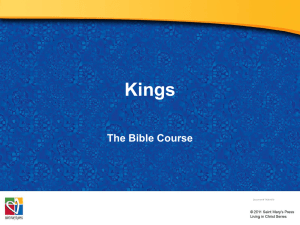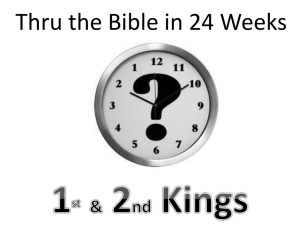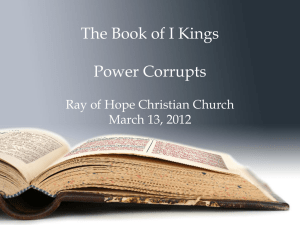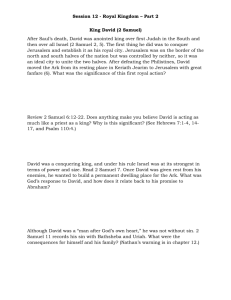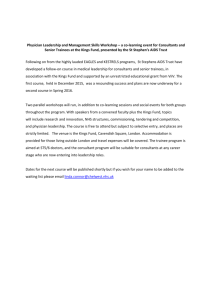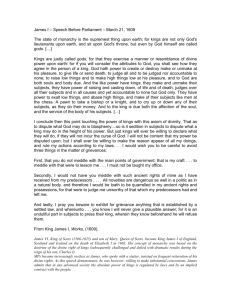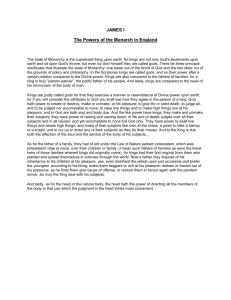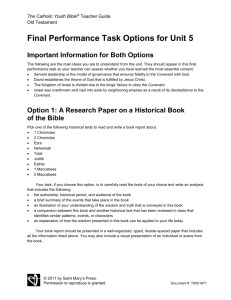huma 1850a the bible in modern contexts
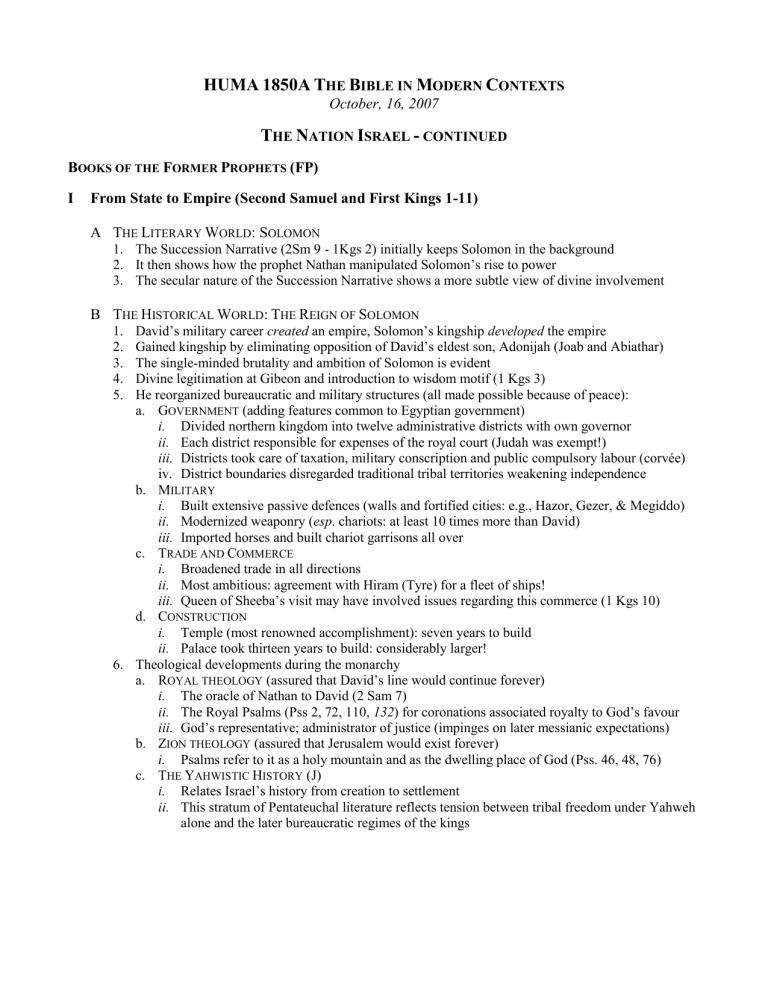
HUMA 1850A T HE B IBLE IN M ODERN C ONTEXTS
October, 16, 2007
T HE N ATION I SRAEL CONTINUED
B
OOKS OF THE
F
ORMER
P
ROPHETS
(FP)
I From State to Empire (Second Samuel and First Kings 1-11)
A T
HE
L
ITERARY
W
ORLD
: S
OLOMON
1. The Succession Narrative (2Sm 9 - 1Kgs 2) initially keeps Solomon in the background
2. It then shows how the prophet Nathan manipulated Solomon’s rise to power
3. The secular nature of the Succession Narrative shows a more subtle view of divine involvement
B T HE H ISTORICAL W ORLD : T HE R EIGN OF S OLOMON
1. David’s military career created an empire, Solomon’s kingship developed the empire
2. Gained kingship by eliminating opposition of David’s eldest son, Adonijah (Joab and Abiathar)
3. The single-minded brutality and ambition of Solomon is evident
4. Divine legitimation at Gibeon and introduction to wisdom motif (1 Kgs 3)
5. He reorganized bureaucratic and military structures (all made possible because of peace): a. G OVERNMENT (adding features common to Egyptian government) i.
Divided northern kingdom into twelve administrative districts with own governor ii.
Each district responsible for expenses of the royal court (Judah was exempt!) iii.
Districts took care of taxation, military conscription and public compulsory labour (corvée) iv. District boundaries disregarded traditional tribal territories weakening independence b. M ILITARY i.
Built extensive passive defences (walls and fortified cities: e.g., Hazor, Gezer, & Megiddo) ii.
Modernized weaponry ( esp . chariots: at least 10 times more than David) iii.
Imported horses and built chariot garrisons all over c. T RADE AND C OMMERCE i. Broadened trade in all directions ii. Most ambitious: agreement with Hiram (Tyre) for a fleet of ships! iii.
Queen of Sheeba’s visit may have involved issues regarding this commerce (1 Kgs 10) d. C ONSTRUCTION i.
Temple (most renowned accomplishment): seven years to build ii.
Palace took thirteen years to build: considerably larger!
6. Theological developments during the monarchy a. R OYAL THEOLOGY (assured that David’s line would continue forever) i.
The oracle of Nathan to David (2 Sam 7) ii.
The Royal Psalms (Pss 2, 72, 110, 132
) for coronations associated royalty to God’s favour iii.
God’s representative; administrator of justice (impinges on later messianic expectations) b. Z ION THEOLOGY (assured that Jerusalem would exist forever) i.
Psalms refer to it as a holy mountain and as the dwelling place of God (Pss. 46, 48, 76) c. T
HE
Y
AHWISTIC
H
ISTORY
(J) i. Relates Israel’s history from creation to settlement ii. This stratum of Pentateuchal literature reflects tension between tribal freedom under Yahweh alone and the later bureaucratic regimes of the kings
– 2 –
II From Empire to Exile: The Divided Kingdom (First Kings 12-22, Second Kings)
A T
HE
L
ITERARY
W
ORLD
: T
HE
P
ATTERNING OF
H
ISTORY IN
K
INGS
(
BY
DH
AUTHOR
)
1. Repeated use of a formula to summarize and assess the reigns of the kings a. Includes reference to historical source, length of reign, and naming successor b. All northern Israelite kings assessed negatively c. Only two southern Judean kings praised (Hezekiah and Josiah)
2. The role of prophets and prophecy a. DH has a very particular view of prophets and formulates the narrative accordingly b. Deuteronomy 13 (false prophets) and 18 (true prophets)
B T HE H ISTORICAL W ORLD
1. Two narratives cover the period of the Divided Kingdom a. 1 Kings 12 - 2 Kings 25 i . DH material completed during exilic period ( ca . 550 B.C.E.) ii.
Use of several sources that are cited but no longer available b 2 Chronicles 10-36 i.
Three features render it less useful than the DH:
• it repeats much of the information
• it frequently alters details to serve specific theological purposes
• it displays an almost exclusive interest in the southern kingdom
2. Features that characterize the DH narrative (1 Kings 12 - 2 Kings 25) a. Theological assumption guides the construction of the narrative: i.
Faithfulness to Sinai covenant brought blessing; disobedience resulted in national ruin b. Focus is on the kings of both kingdoms but they are judged according to DH theology c. Bias towards Judah is evident and due to the fact that DH is a southern source d. Selective coverage of events leaves significant gaps in the history
3. The Division of the Kingdom: Four Specific Causes a. Pro-Saul people in the north unhappy with Davidic line replacing him b. Solomon’s heavy taxation and forced labour more pronounced on the northern kingdom c. Centralization of the cult to Jerusalem deemphasized the northern shrines d. Solomon’s son Rehoboam, trying to enforce a more oppressive policy, the final straw!
4. THE NORTHERN KINGDOM (922-722 B.C.E.
) a. J EROBOAM I i.
Served under Solomon who tried to kill him and so fled to Egypt ii.
Chosen to be first king of Northern Kingdom iii.
Israel dominated in size, economy and military strength over Judah iv.
DH concentrates on his religious reforms: reactivation of northern Yahwistic shrines at
Dan and Bethel (golden calves: see Ex. 32) v.
Rejection of both Davidic and Zion theology (but not Yahwism!) b. F OUR DIFFERENT KINGS i. None were able to stabilize the monarchy losing territory and power along the way c. T HE O MRID D YNASTY (result of a successful coup) i.
Omri moved capital to Samaria and its splendour was unrivalled in Palestine ii.
Enhanced Israel’s internat’l standing thro’ political alliances (son Ahab married to Jezebel) iii.
Jezebel’s Baalism was a serious challenge to Yahwism and DH heightens the drama with a number of narratives focusing on this struggle d. T HE J EHU D YNASTY (result of a successful & very bloody coup urged by the prophet Elisha) i.
Overthrowing the Omrids placed Israel in conflict with neighbouring states ii.
Jeroboam II managed to restored Israel’s boundaries back to that of the old Davidic kingdom iii.
Prophets Amos and Hosea attacked social injustices exhibited during this time e. T HE F ALL OF I SRAEL (722 B.C.E
.)
– 3 – i.
Followed five successive kings who simply added to internal disintegration ii.
Assyrian expansion and consolidation under Tiglath-pileser III threatened iii.
Syro-Israelite alliance sought Judean support against Assyria but did not obtain it (see Ahaz) iv . Assyrian program of deportation resettled Israelites throughout Mesopotamia and replaced with people imported from other areas of the empire
5. THE SOUTHERN KINGDOM (922-587 B.C.E.
) a. R EHOBOAM (922-915) i.
Solomon’s son who refused to heed advice to lessen the economic burden on Israel ii.
Caused economical dependence on Egypt and initiated the weaker of the two kingdoms b. A HAZ (735-715) i.
Agreed to be a vassal of Assyria at an economic cost ii.
Opened Judah to Assyrian religious practices; constructed an altar in Temple for their gods iii . Kings of Israel and Aram siege Jerusalem; Isaiah comforts him with a prophecy (Isa 7) c. H EZEKIAH (715-687) i.
Instituted reforms focused on eradicating foreign worship and strengthening Yahwism ii.
Led to direct conflict with Assyria, Assyrian forces attacked but then mysterious retreated d. M ANASSEH (687-642) i.
Reversed his father’s policies in terms of Yahwism; presented as the worst king ever! ii . His long reign was theologically problematic, Chronicles adds a repentance story (2 Ch 33) e. J OSIAH i.
Counted as one of Judah’s greatest kings with his sweeping reforms upon discovering
“the book of the law” (Deut 12-26) in the Temple:
• Temple cult in Jerusalem purified by eradicating Assyrian and Canaanite worship
• Local shrines around Judean countryside were purged of non-Yahwistic elements
• Reform extended into area of former Northern Kingdom (exaggeration?)
• Reform represented a virtual declaration of independence from Assyria ii.
Scholars believe first version of DH recorded at this time
• Optimistism and enthusiasm about Josiah’s successful consolidation of national religion
• Like a second Joshua, he conquers and then has a covenant renewal with Passover
• Death of Josiah at the hands of Egypt Pharoah was not expected! f. T HE F ALL OF J UDAH (587 B.C.E
) i.
The rise of Babylon was the beginning of the end for Judah ii.
Attempts at revolt from Babylonian imperialism led to deportation iii.
Second edition of DH created to make the ultimate disaster appear inevitable
• did not alter the terms of the original Davidic covenant (unconditional)
• rephrased later references in order to making it conditional on king’s loyalty to Yahweh
(1 Kgs. 9:4-9, Ps 132) and blaming Manasseh for having provoked Yahweh (2 Kgs 23:26-27) iv.
Note that the demise of Judah specifically is not ever mentioned in the Babylonian records
T ONIGHT
’
S T UTORIAL A SSIGNMENT :
Reread Solomon's temple dedication prayer in 1 Kings 8:22-9:9. What do you see in its contents that suggest it was not something he could have or would have said? Isolate expressions or sentences that you find strange in a dedicatory prayer for something that is suppose to be the greatest moment in Israelite history. When would you say it was likely written?
T UTORIAL P REPARATION FOR N EXT W EEK :
Isaiah was one of four OT prophets who operated during the eighth century B.C.E. While Amos and Hosea concentrated their labours on the Northern Kingdom, Micah and Isaiah dealt with the Southern Kingdom. Read carefully chapter seven of Isaiah and do not ignore the information in the footnotes. Paraphrase in your own words what is happening at this time. Who are the important people in this incident? What is their relationship to each other? Why are they interacting at this time? Why does
Isaiah make an appearance? Why does he give a prophecy and what does it mean in the context of the story? Interpret the prophecy in terms of its original situation. In other words, try NOT to see it as the Gospel writer, Matthew, sees it (Matt.
1:22-23).
– 4 –
